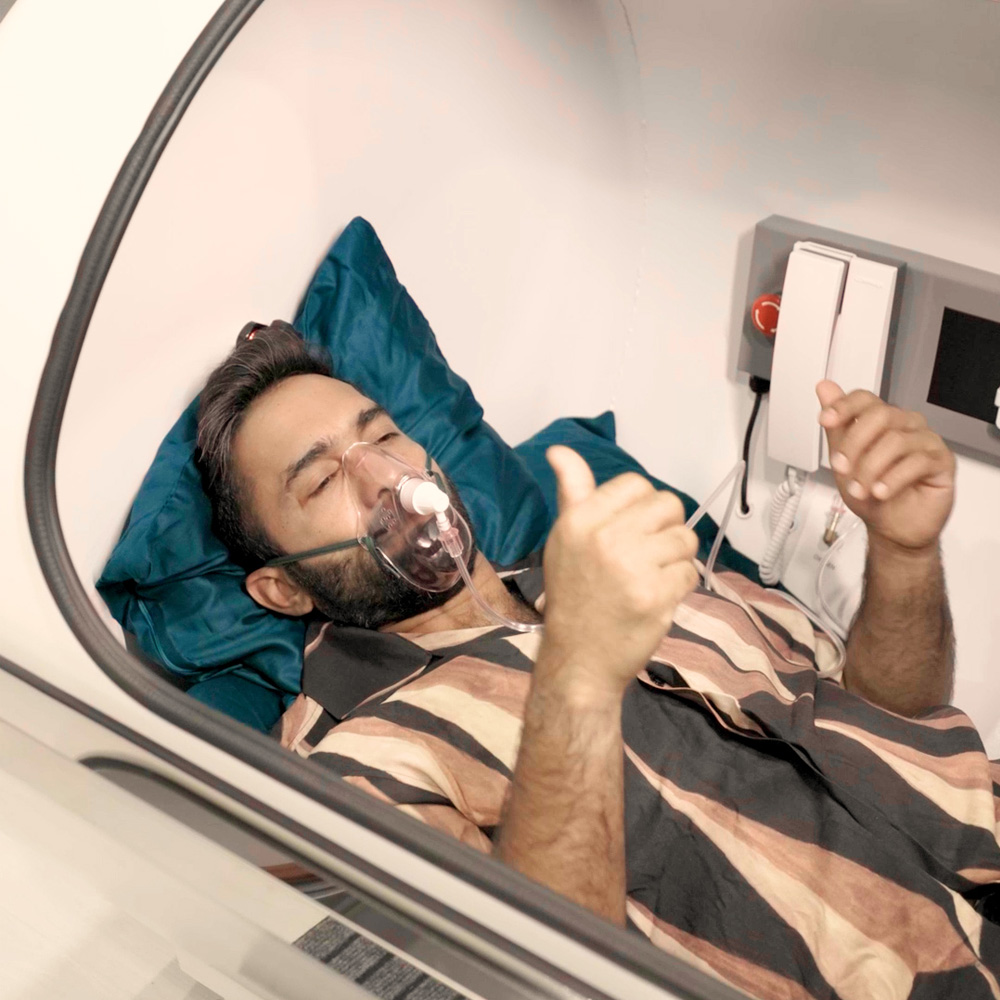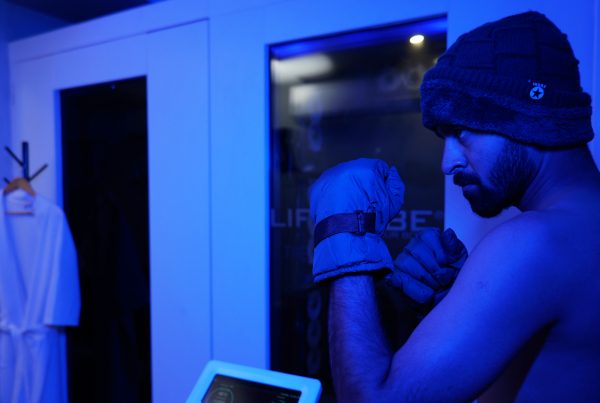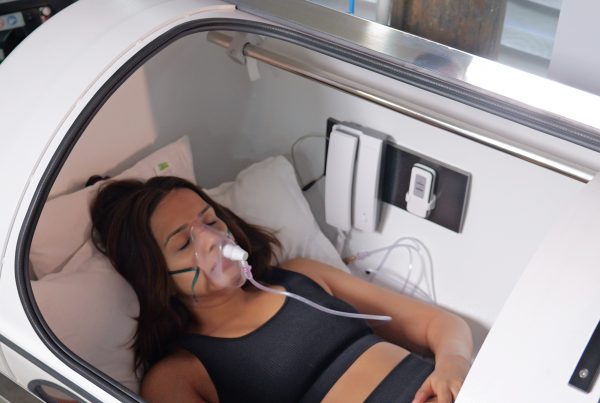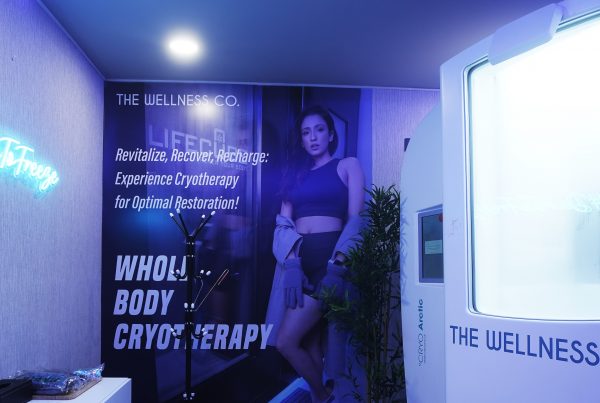Hyperbaric Chamber Therapy, otherwise known as Hyperbaric Oxygen Therapy (HBOT), was first used in the U.S. in the early 1900s. Later, it was used to treat decompression sickness, a hazard of scuba diving. Today, HBOT is prescribed and supervised medically by institutions such as Mayo Clinic, and it may even be covered by insurance (depending on the condition it’s used to treat).
Explore how exactly hyperbaric chambers work, and what type of ailments HBOT is commonly used to treat. Are they controversial, and perhaps most importantly, what does the research say about its efficacy and safety?
How Does HBOT Work?
One method of HBOT involves a person receiving the treatment inside of a tube-like chamber. Some tubes are made of clear acrylic, allowing patients to see outside of the chamber. This transparency may eliminate some of the potential anxiety a person may have of feeling trapped inside the tube.
During HBOT, a patient is instructed to lie down in the enclosed chamber and breathe the air inside the tube as the pressure is gradually increased.
Another mode of treatment, such as that offered at Mayo Clinic, is a multi-person hyperbaric oxygen room, where oxygen is delivered via a mask or a lightweight clear hood placed over the head. In this scenario, a person can sit or lie down in a lounge chair—there is no tube or chamber with this method.
Increased Oxygen Supply
There is no way of controlling how much oxygen gets absorbed into the body. HBOT is a way to hypothetically turn up the volume of oxygen absorption by increasing the atmospheric pressure. The pressure inside the chamber is normally two to three times greater than outside air pressure, which means patients are inhaling 100% oxygen.
Hyperbaric chambers work by providing oxygen that can be controlled. Normally, oxygen is transported throughout the body—after it initially gets absorbed by the lungs—then circulates to all the tissues and organs via the heart and blood vessels.
HBOT allows for oxygen to be dissolved in the blood, body fluids, cerebral spinal fluid (the fluid that surrounds the brain and spinal column), bone tissue, and lymph nodes. Oxygen-rich fluids in the body can then travel to areas where blood circulation is blocked.
HBOT is said to help the body by assisting with the following functions:
- Helping the immune cells of the body to kill bacteria
- Reducing inflammation
- Allowing for collateral circulation (growth of new blood vessels to provide extra oxygen to affected areas of the body)
Health Benefits
The body needs oxygen to heal itself. Many injuries and illnesses involve the lack of oxygen-rich blood, which is then unable to travel to affected areas of the body.
For example, diabetes can result in poor and slowed circulation, making it more difficult for oxygen-rich red blood cells to reach wounded areas of the skin. This results in injuries that are very slow to heal or injuries that do not heal at all.
HBOT has been used to treat many different medical conditions and injuries that benefit from having an increased level of oxygen in the tissues. Hyperbaric oxygen therapy can be utilized as a stand-alone treatment or a procedure that can boost the action of medicine, such as antibiotics.
Use Cases
Some of the common uses for HBOT that are often covered by insurance include:
- Arterial gas embolism (air bubbles in the blood vessels)
- Carbon monoxide poisoning (from breathing noxious fumes)
- Cyanide poisoning
- Decompression sickness (a common scuba diving condition, also called “the bends”)
- Specific types of non-healing wounds such as diabetic wounds
- Gas gangrene (fast-spreading gangrene in infected wounds that gives off a foul-smelling gas)
- Intracranial abscess (originating from an ear infection, sinus infection, or another primary source of infection)
- Tissue damage from radiation therapy
- Osteomyelitis (long-term inflammation of bone or bone marrow)
- Compromised skin grafts or flaps
- Severe anemia
- Brain abscess
- Burns
- Crushing injury
- Sudden deafness
- Sudden, painless vision loss
Further Conditions
There are several other types of injuries and illnesses that are said to benefit from HBOT, but there is a lack of clinical research evidence to back up many of these claims. Therefore, these conditions are not usually covered by insurance:
- Lyme Disease
- Near drowning
- Recovery from plastic surgery
- AIDS/HIV
- Allergies
- Alzheimer’s disease
- Arthritis
- Asthma
- Autism
- Bell’s palsy
- Brain injury
- Cancer
- Cerebral palsy
- Chronic fatigue syndrome
- Cirrhosis
- Depression
- Fibromyalgia
- Gastrointestinal ulcers
- Heart disease
- Heatstroke
- Hepatitis
- Migraine
- Multiple sclerosis
- Parkinson’s disease
- Spinal cord injury
- Sports Injury
- Stroke
- Traumatic brain injury
Side Effects
The side effects of HBOT are usually mild and temporary, provided some safety measures are followed. These safety measures include that the therapy is administered for no longer than two hours in duration per session and that the pressure inside the chamber is less than three times that of the pressure in the atmosphere.
Preparation
Before treatment, it’s important to shower and avoid all perfumes, deodorants, and hair sprays (and styling products). Wigs and jewelry are not allowed inside the chamber. Alcohol and carbonated drinks should be avoided for at least four hours before HBOT.
Smokers are encouraged to quit smoking during the time span that they receive therapy because tobacco products block the body’s natural ability to transport oxygen.
To minimize problems with ears and sinuses, techniques (such as yawning or swallowing) are taught for adequate clearing of the ears. Sometimes tubes are inserted into the ears to minimize issues that result from pressure in the ears during HBOT.
Traumatic Brain Injury
HBOT has been rated a “promising, safe, therapeutic strategy for severe TBI patients” in trials on humans that included participants who had suffered a severe traumatic brain injury (TBI). Notably, this does not imply that there is solid proof that HBOT is useful for traumatic brain injuries; additional studies in this field are required.
Safety
Three article reviews in one report by the US Government Accountability Office concluded that HBO’s treatment was secure.
For anyone who’s looking to invest in their Health and Wellness, Hyperbaric oxygen therapy is one of the top options. Find out more about Hyperbaric Oxygen Therapy in Gurgaon and its process, only at The Wellness Co.
Book Your Appointment Now!
Hyperbaric Oxygen Therapy is facilitated by The Wellness Co. in cities such as Mumbai, Gurgaon, and New Delhi. The Hyperbaric Oxygen Therapy Cost in Mumbai and Hyperbaric Oxygen Therapy Cost in Delhi starts from Rs. 7000 onwards. Hyperbaric Oxygen Therapy is a medical treatment used to help boost the body’s natural healing.





Pls send me more information about this. I need to start this treatment
wanted to check can the oxygen and red light therapy can we be done for 5 year kid with Autism